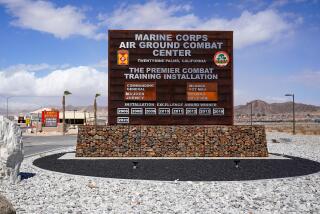More Than Just a Few Good Men at Air Stations
- Share via
The Marine Corps has changed.
Those serving are better educated than ever before, with all officers being college graduates and 95% of the enlisted ranks holding high school diplomas. Those inside the military fences have most of the same hopes, desires and fears as those on the outside. But few outside are aware of it.
“I think maybe we made the mistake in the past of not being very open or forthcoming with the media and saying, ‘Come and take a look at us,’ ” Maj. Gen. Donald E.P. Miller, the former commanding general of the 3rd Marine Air Wing at El Toro and Tustin, once said. “Go talk to some of these young men and women, both the junior enlisted Marines and the young officers who are flying these $20-million machines.
“What you are going to find is a pretty articulate, pretty well-educated, pretty dedicated young man or woman,” said Miller, who was reassigned in August and is now in Washington in charge of planning for the Marine Corps.
The 54-year-old general often urged journalists to spend time with Marines and see what they do.
Under Miller, a lot of attitudes changed. And that open-door policy is being continued by Maj. Gen. Royal N. Moore Jr., the new commanding general of the 3rd Marine Aircraft Wing.
Reporters who took Miller up on the offer found that Marines not only are able to fly sophisticated fighter jets and helicopters, but they are able to take care of the aircraft as well. Enlisted men at the El Toro and Tustin Marine Corps air stations are familiar with every part of a F/A-18 Hornet and the CH-53 Super Stallion.
There are about 11,000 Marines who work at the two Marine Corps air stations in Orange County. Thousands more are stationed just across the county line at Camp Pendleton.
Many of those who work at the air stations at El Toro and Tustin drive into Orange County to work each day and drive out each night because most of them cannot afford to live here. And since the military base is closed to the public, Orange County residents have little contact with them.
But we are aware of the newspaper and television reports that feature stories about Marines or former Marines involved in robberies, murder, or even trading secrets to the enemy. We remember Lt. Col. Oliver North or maybe Joseph Thomas, who was convicted in an El Toro court-martial of beating his wife to death and then trying to make it look like suicide.
News often is made when a Marine helicopter or jet crashes.
Those are the exceptions.
Last year I spent time in the Sierra near Bridgeport doing a story on the Marine Corps winter survival school. When your group is thrown out into the cold without food for six days at 9,000 feet and live in a snow hut in temperatures below zero with blizzard-type winds, you get to know each other quickly.
There were chores that had to be done each day. Wood had to be cut for the fire. Water had to be carried from the ice-covered streams. Traps had to be set to catch food. Someone had to cut a hole in the ice and stand there for hours waiting for a fish to take the bait. When the fish did not bite, we shared the bait.
While we were out in the snow, there was time to learn about each other.
Most had families. They worried about how much it would cost to send their kids to college. They had mortgage payments. They had to buy groceries every week on salaries that were a lot less than many in Orange County.
But what impressed me most was that they cared about what they were doing. They spent a lot of time talking about how they might do their jobs better.
Recently I spent a couple of days off the California coast for a story on pilots from El Toro attempting their first night landings on an aircraft carrier. There was a lot of pressure because if they failed to qualify they could no longer fly as a Marine or Navy fighter pilot.
One of the pilots was Capt. Stephen Pomeroy. On his second night just after he was launched from the carrier deck, a warning light indicated that his landing gear was not operating properly. He was diverted to Miramar Naval Air Station in San Diego rather than attempt a landing on the carrier.
Pomeroy landed his F/A-18 at Miramar without a problem, but as he was climbing down from the cockpit, a small ladder gave way and he fell to the Tarmac. He broke his right wrist, the one used to guide the airplane.
The next day Pomeroy flew back to the carrier. And he knew he had to make the required landings to qualify. Without mentioning his broken, swollen wrist, he flew the next two nights. Even with the handicap, he landed the supersonic fighter jet on the deck’s small landing area.
He qualified.
More to Read
Sign up for Essential California
The most important California stories and recommendations in your inbox every morning.
You may occasionally receive promotional content from the Los Angeles Times.













